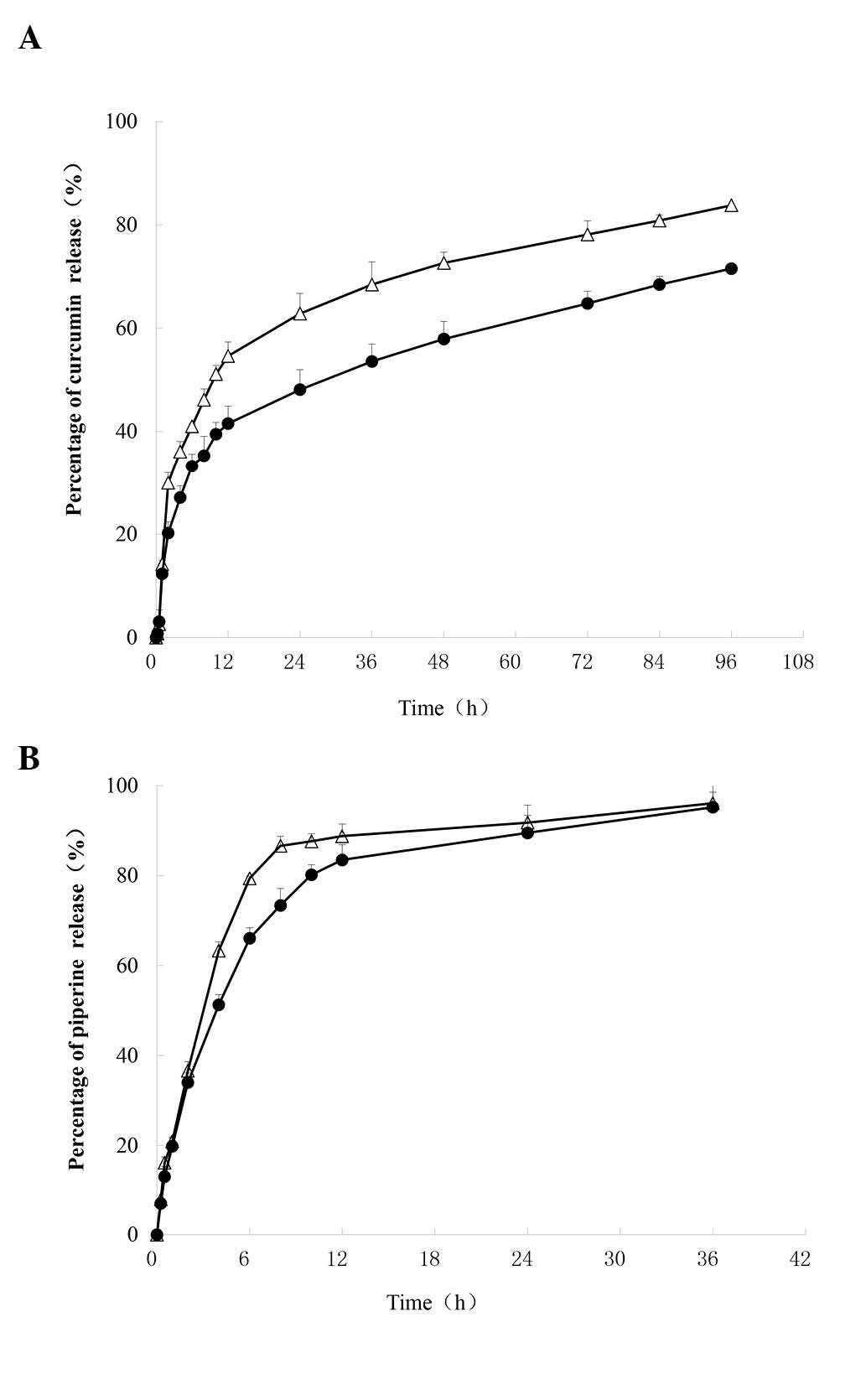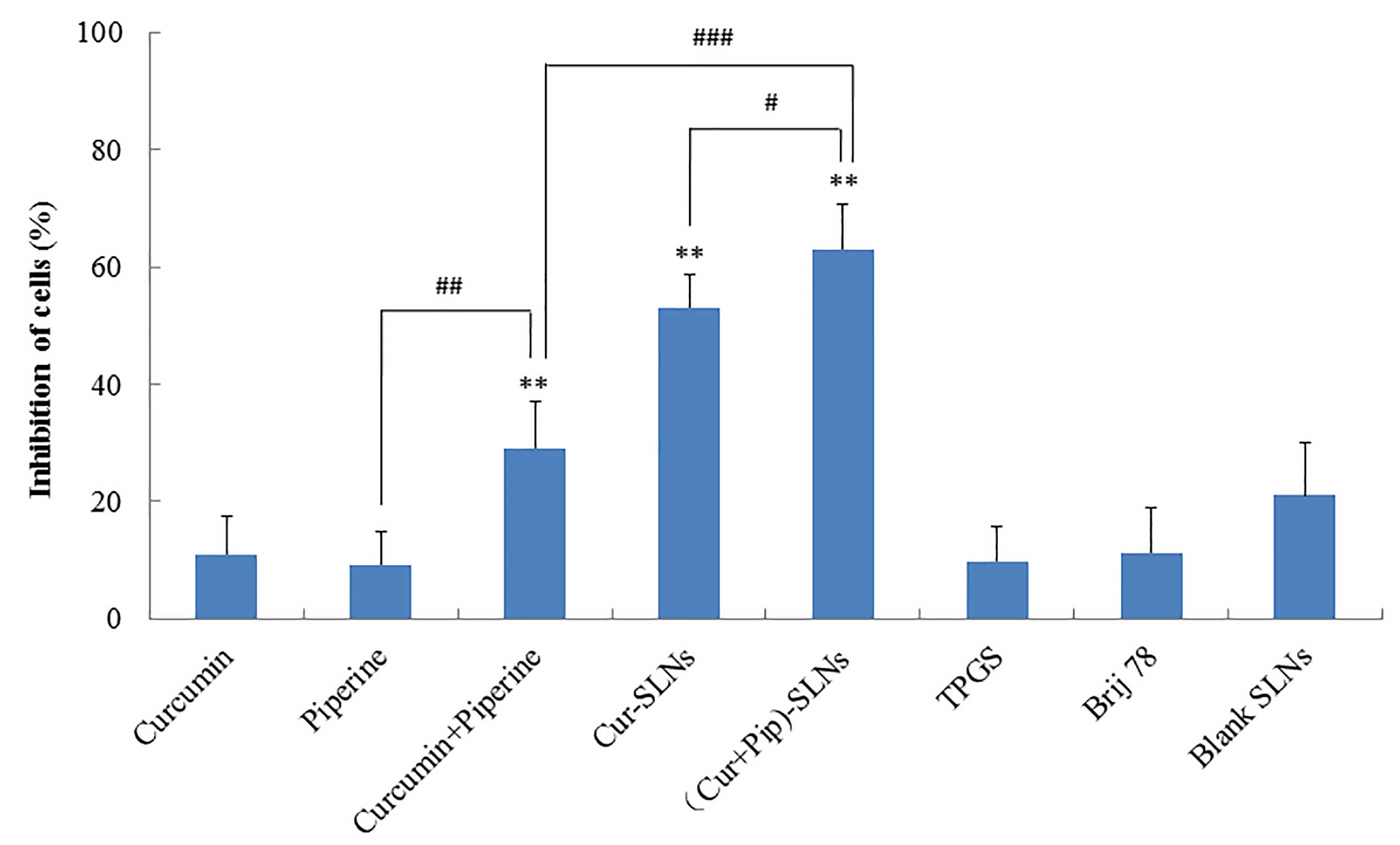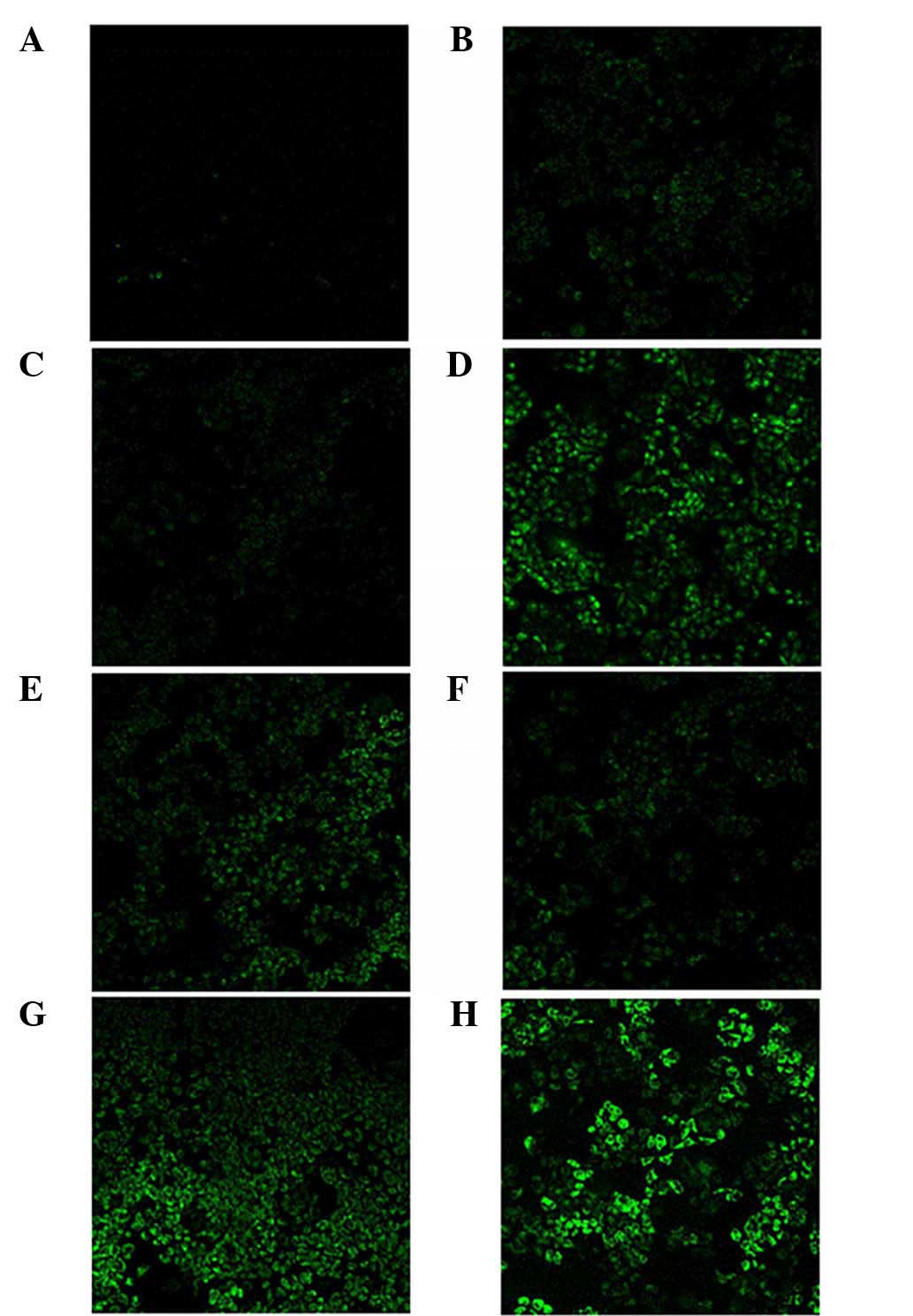|
1
|
Fodale V, Pierobon M, Liotta L and
Petricoin E: Mechanism of cell adaptation: When and how do cancer
cells develop chemoresistance? Cancer J. 17:89–95. 2011. View Article : Google Scholar : PubMed/NCBI
|
|
2
|
Kathawala RJ, Gupta P, Ashby CR Jr and
Chen ZS: The modulation of ABC transporter-mediated multidrug
resistance in cancer: A review of the past decade. Drug Resist
Updat. 18:1–17. 2015. View Article : Google Scholar : PubMed/NCBI
|
|
3
|
Shapira A, Livney YD, Broxterman HJ and
Assaraf YG: Nanomedicine for targeted cancer therapy: Towards the
overcoming of drug resistance. Drug Resist Updat. 14:150–163. 2011.
View Article : Google Scholar : PubMed/NCBI
|
|
4
|
Anand P, Kunnumakkara AB, Newman RA and
Aggarwal BB: Bioavailability of curcumin: Problems and promises.
Mol Pharm. 4:807–818. 2007. View Article : Google Scholar : PubMed/NCBI
|
|
5
|
Aggarwal BB, Shishodia S, Takada Y,
Banerjee S, Newman RA, Bueso-Ramos CE and Price JE: Curcumin
suppresses the paclitaxel-induced nuclear factor-kappaB pathway in
breast cancer cells and inhibits lung metastasis of human breast
cancer in nude mice. Clin Cancer Res. 11:7490–7498. 2005.
View Article : Google Scholar : PubMed/NCBI
|
|
6
|
Aggarwal BB: Nuclear factor-kappaB: The
enemy within. Cancer Cell. 6:203–208. 2004. View Article : Google Scholar : PubMed/NCBI
|
|
7
|
Limtrakul P, Chearwae W, Shukla S,
Phisalphong C and Ambudkar SV: Modulation of function of three ABC
drug transporters, P-glycoprotein (ABCB1), mitoxantrone resistance
protein (ABCG2) and multidrug resistance protein 1 (ABCC1) by
tetrahydrocurcumin, a major metabolite of curcumin. Mol Cell
Biochem. 296:85–95. 2007. View Article : Google Scholar : PubMed/NCBI
|
|
8
|
Chearwae W, Wu CP, Chu HY, Lee TR,
Ambudkar SV and Limtrakul P: Curcuminoids purified from turmeric
powder modulate the function of human multidrug resistance protein
1 (ABCC1). Cancer Chemother Pharmacol. 57:376–388. 2006. View Article : Google Scholar : PubMed/NCBI
|
|
9
|
Ganta S and Amiji M: Coadministration of
Paclitaxel and curcumin in nanoemulsion formulations to overcome
multidrug resistance in tumor cells. Mol Pharm. 6:928–939. 2009.
View Article : Google Scholar : PubMed/NCBI
|
|
10
|
Romiti N, Tongiani R, Cervelli F and
Chieli E: Effects of curcumin on P-glycoprotein in primary cultures
of rat hepatocytes. Life Sci. 62:2349–2358. 1998. View Article : Google Scholar : PubMed/NCBI
|
|
11
|
Bisht S, Feldmann G, Soni S, Ravi R,
Karikar C and Maitra A and Maitra A: Polymeric
nanoparticle-encapsulated curcumin (‘nanocurcumin’): A novel
strategy for human cancer therapy. J Nanobiotechnology. 5:32007.
View Article : Google Scholar : PubMed/NCBI
|
|
12
|
Maiti K, Mukherjee K, Gantait A, Saha BP
and Mukherjee PK: Curcumin-phospholipid complex: Preparation,
therapeutic evaluation and pharmacokinetic study in rats. Int J
Pharm. 330:155–163. 2007. View Article : Google Scholar : PubMed/NCBI
|
|
13
|
Tiyaboonchai W, Tungpradit W and
Plianbangchang P: Formulation and characterization of curcuminoids
loaded solid lipid nanoparticles. Int J Pharm. 337:299–306. 2007.
View Article : Google Scholar : PubMed/NCBI
|
|
14
|
Shaikh J, Ankola DD, Beniwal V, Singh D
and Kumar MN: Nanoparticle encapsulation improves oral
bioavailability of curcumin by at least 9-fold when compared to
curcumin administered with piperine as absorption enhancer. Eur J
Pharm Sci. 37:223–230. 2009. View Article : Google Scholar : PubMed/NCBI
|
|
15
|
Shoba G, Joy D, Joseph T, Majeed M,
Rajendran R and Srinivas PS: Influence of piperine on the
pharmacokinetics of curcumin in animals and human volunteers.
Planta Med. 64:353–356. 1998. View Article : Google Scholar : PubMed/NCBI
|
|
16
|
Bhardwaj RK, Glaeser H, Becquemont L,
Klotz U, Gupta SK and Fromm MF: Piperine, a major constituent of
black pepper, inhibits human P-glycoprotein and CYP3A4. J Pharmacol
Exp Ther. 302:645–650. 2002. View Article : Google Scholar : PubMed/NCBI
|
|
17
|
Najar IA, Sachin BS, Sharma SC, Satti NK,
Suri KA and Johri RK: Modulation of P-glycoprotein ATPase activity
by some phytoconstituents. Phytother Res. 24:454–458. 2010.
View Article : Google Scholar : PubMed/NCBI
|
|
18
|
Li S, Lei Y, Jia Y, Li N, Wink M and Ma Y:
Piperine, a piperidine alkaloid from Piper nigrum re-sensitizes
P-gp, MRP1 and BCRP dependent multidrug resistant cancer cells.
Phytomedicine. 19:83–87. 2011. View Article : Google Scholar : PubMed/NCBI
|
|
19
|
Kabanov AV, Batrakova EV and Alakhov VY:
An essential relationship between ATP depletion and
chemosensitizing activity of Pluronic block copolymers. J Control
Release. 91:75–83. 2003. View Article : Google Scholar : PubMed/NCBI
|
|
20
|
Batrakova EV, Li S, Brynskikh AM, Sharma
AK, Li Y, Boska M, Gong N, Mosley RL, Alakhov VY, Gendelman HE and
Kabanov AV: Effects of pluronic and doxorubicin on drug uptake,
cellular metabolism, apoptosis and tumor inhibition in animal
models of MDR cancers. J Control Release. 143:290–301. 2010.
View Article : Google Scholar : PubMed/NCBI
|
|
21
|
Guo Y, Luo J, Tan S, Otieno BO and Zhang
Z: The applications of Vitamin E TPGS in drug delivery. Eur J Pharm
Sci. 49:175–186. 2013. View Article : Google Scholar : PubMed/NCBI
|
|
22
|
Dong X, Mattingly CA, Tseng MT, Cho MJ,
Liu Y, Adams VR and Mumper RJ: Doxorubicin and paclitaxel-loaded
lipid-based nanoparticles overcome multidrug resistance by
inhibiting P-glycoprotein and depleting ATP. Cancer Res.
69:3918–3926. 2009. View Article : Google Scholar : PubMed/NCBI
|
|
23
|
Tang J, Wang Y, Wang D, Wang Y, Xu Z,
Racette K and Liu F: Key structure of brij for overcoming multidrug
resistance in cancer. Biomacromolecules. 14:424–430. 2013.
View Article : Google Scholar : PubMed/NCBI
|
|
24
|
Patel BD, Modi RV, Thakkar NA, Patel AA
and Thakkar PH: Development and characterization of solid lipid
nanoparticles for enhancement of oral bioavailability of
Raloxifene. J Pharm Bioallied Sci. 4:(Suppl 1). S14–S16. 2012.
View Article : Google Scholar : PubMed/NCBI
|
|
25
|
Loveless VS, Surdock CP and Bhattacharjee
H: Evaluation of zeta-potential and particle size of technetium
99mTc-sulfur colloid subsequent to the addition of lidocaine and
sodium bicarbonate. J Nucl Med Technol. 38:49–52. 2010. View Article : Google Scholar : PubMed/NCBI
|
|
26
|
Yusuf M, Khan RA, Khan M and Ahmed B:
Plausible antioxidant biomechanics and anticonvulsant
pharmacological activity of brain-targeted β-carotene
nanoparticles. Int J Nanomedicine. 7:4311–4321. 2012.PubMed/NCBI
|
|
27
|
Raghunand N, He X, Van Sluis R, Mahoney B,
Baggett B, Taylor CW, Paine-Murrieta G, Roe D, Bhujwalla ZM and
Gillies RJ: Enhancement of chemotherapy by manipulation of tumour
pH. Br J Cancer. 80:1005–1011. 1999. View Article : Google Scholar : PubMed/NCBI
|
|
28
|
Singh DV, Godbole MM and Misra K: A
plausible explanation for enhanced bioavailability of P-gp
substrates in presence of piperine: Simulation for next generation
of P-gp inhibitors. J Mol Model. 19:227–238. 2013. View Article : Google Scholar : PubMed/NCBI
|
|
29
|
Szakács G, Paterson JK, Ludwig JA,
Booth-Genthe C and Gottesman MM: Targeting multidrug resistance in
cancer. Nat Rev Drug Discov. 5:219–234. 2006. View Article : Google Scholar : PubMed/NCBI
|
|
30
|
Eytan GD, Regev R, Oren G, Hurwitz CD and
Assaraf YG: Efficiency of P-glycoprotein-mediated exclusion of
rhodamine dyes from multidrug-resistant cells is determined by
their passive transmembrane movement rate. Eur J Biochem.
248:104–112. 1997. View Article : Google Scholar : PubMed/NCBI
|
|
31
|
Tang J, Wang Y, Wang D, Xu Z, Racette K
and Liu F: Key structure of brij for overcoming multidrug
resistance in cancer. Biomacromolecules. 14:424–430. 2013.
View Article : Google Scholar : PubMed/NCBI
|
|
32
|
Tang J, Fu Q, Wang Y, Racette K, Wang D
and Liu F: Vitamin E reverses multidrug resistance in vitro and in
vivo. Cancer Lett. 336:149–157. 2013. View Article : Google Scholar : PubMed/NCBI
|















